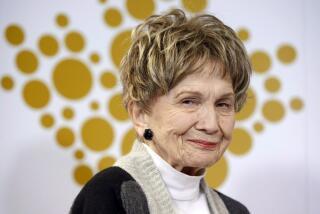Review: When Maurice Ravel, a painter and an UCSF neurologist connected on Zoom
- Share via
In the new play “UnRavelled,” writer Jake Broder explores two case studies in brain science that echo uncannily across time. The French composer Maurice Ravel wrote his best known piece, “Boléro,” in 1928 at age 53. In the 1990s, also at 53, an American scientist named Anne Adams abruptly abandoned her career to paint. In her canvas “Unravelling Boléro,” she obsessively translated Ravel’s notes and rhythms into a visual language all her own. Both artists died of the same rare brain disease.
Their stories raise questions that compel neuroscientists, while also falling in Broder’s wheelhouse as an actor, musician, composer and playwright interested in the mysteries of creativity. After getting hooked on the Ravel-Adams connection during a public radio segment, Broder reached out to Adams’ neurologist, Dr. Bruce Miller, director of the Memory and Aging Center at UC San Francisco. Miller invited Broder to the center as a visiting artist; Broder in turn warmly immortalized Miller as a character in “UnRavelled,” now in a digital production and free to view on demand through June 30.
The show is filmed pandemic-style, each actor safely enclosed in a separate Zoom window. Director Nike Doukas and her video engineers, Bree Pavey and Corwin Evans, deal them like playing cards against a black screen in groupings that, with the help of narrated stage directions (by Michael Lanahan), establish the various settings. Wisely, Broder avoids interactions requiring scenery, props or costumes, telling his story largely through one-on-one conversations. Although Zoom is a notoriously claustrophobic medium, in some sense its limitations work here: The characters’ isolation in separate boxes visually reinforces the emotional distance among them.
Connection proves challenging for protagonists Anne Adams (Lucy Davenport) and her husband, Robert (Rob Nagle), long married and emerging from a crisis involving their son. The young man has recovered, but over Scrabble one night, Anne tells Robert she doesn’t intend to go back to work as she’d planned. Instead, she wants to paint.
COVID-19 restrictions are loosening for cultural institutions even though health experts urge caution. We’ve haven’t yet won the fight.
With equal parts tenderness, hurt feelings and exasperation (a mixture Nagle excels at conveying), Robert reminds Anne that she’s not an artist; her mediocre portraits of strawberries don’t justify the forfeiture of her income. Anne, whom Davenport portrays as an emotionally self-sufficient, not to say remote, love object, good-naturedly agrees but doesn’t change her mind. Every day she gets a little bit quirkier, until she is shut up in her studio blasting “Boléro,” leaving Robert to deal alone with his worry, yearning and existential confusion, not to mention a disheartening job.
In between their tense dinners, we meet Dr. Miller, who will eventually treat Anne, as he delivers a lecture on art and the brain. As played by Leo Marks, Dr. Miller is figure of preternatural erudition, wit and compassion. Without minimizing Anne and Robert’s pain, he communicates his enthrallment by the light their experience shines on ancient questions: Is there a physical or chemical source in the brain of artistic inspiration? If art is a symptom of disease, what is the artist’s role, if any, in its creation?
Ravel has something to contribute to this discussion: “Boléro,” with its insistent repetition, broke radically from his previous style, and he later resented its success, complaining that it has “no music in it.” Ravel shows up in “UnRavelled,” played by Conor Duffy, in a slightly cooler color palette suggesting his vintage. He has imaginary conversations with Anne and hangs out in his own era with his friend Ida (Melissa Greenspan), the ballerina for whom he wrote “Boléro.” These scenes demonstrate how closely Ravel’s disease mirrored Anne’s — frenzied, uncharacteristic creativity followed by aphasia — but because we get the idea early on, and don’t learn much else about him, Ravel’s subplot threatens to wear out its welcome.
As the play progresses, it starts to repeat itself or belabor its points: There is a sense that it wants to leave more to the audience’s imagination, to evoke rather than spell out connections, and to open out onto a greater vision of human inspiration and struggle. But it’s gotten stuck in a Zoom meeting. The medium lets the material down most at its climax, a bar-by-bar comparison of “Boléro” with “Unravelling Boléro.” On my laptop this juxtaposition had all the grandeur of a PowerPoint presentation. But the strength of the writing and performances helped me imagine how thrilling it could be in another context.
'UnRavelled'
What: A digital production by the Global Brain Health Institute based at Trinity College Dublin and by UC San Francisco and USCF Memory and Aging Center
When: On demand; extended to June 30
Where: www.UnRavelledPlay.com
Tickets: Free
Running time: 1 hour, 30 minutes
More to Read
The biggest entertainment stories
Get our big stories about Hollywood, film, television, music, arts, culture and more right in your inbox as soon as they publish.
You may occasionally receive promotional content from the Los Angeles Times.










